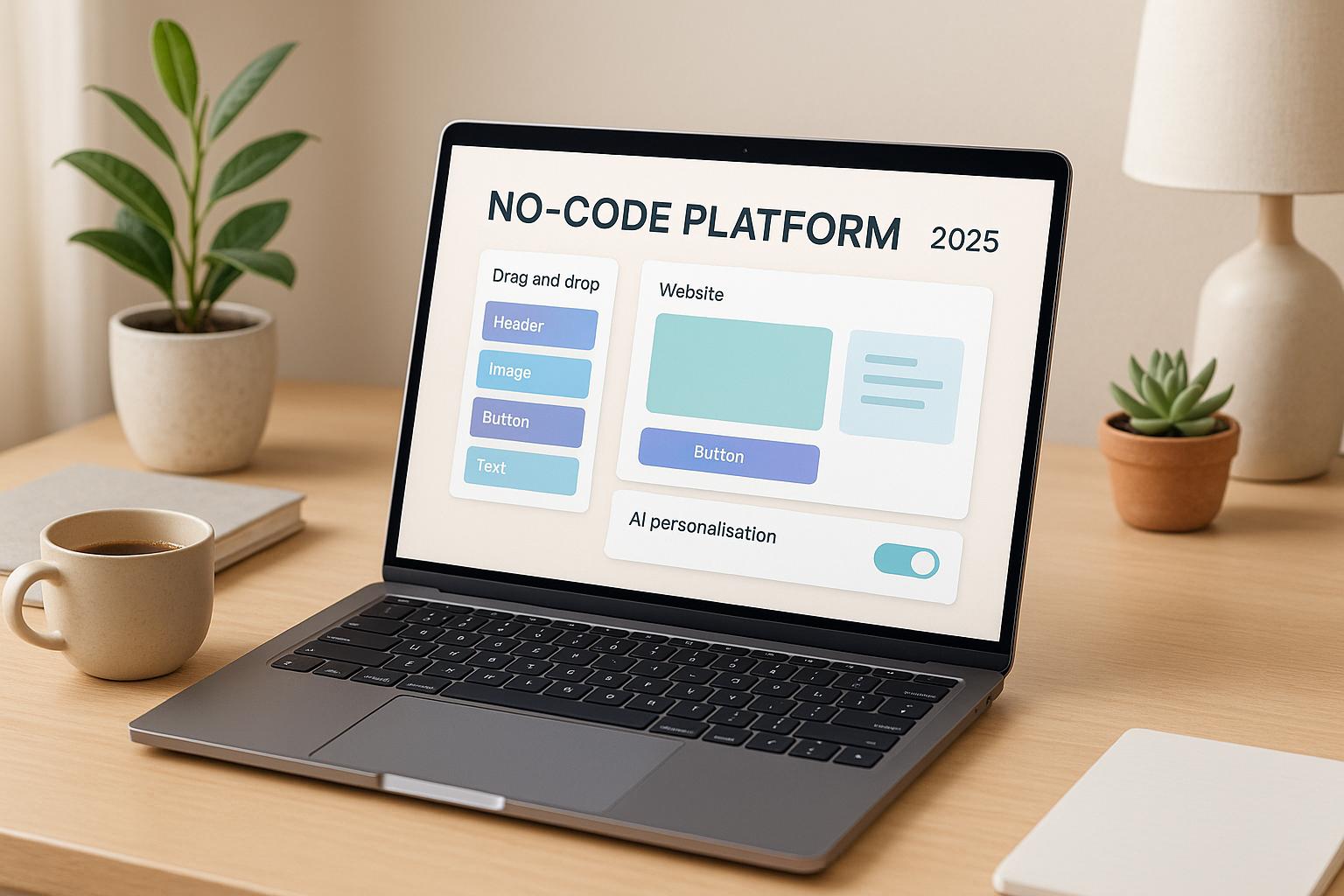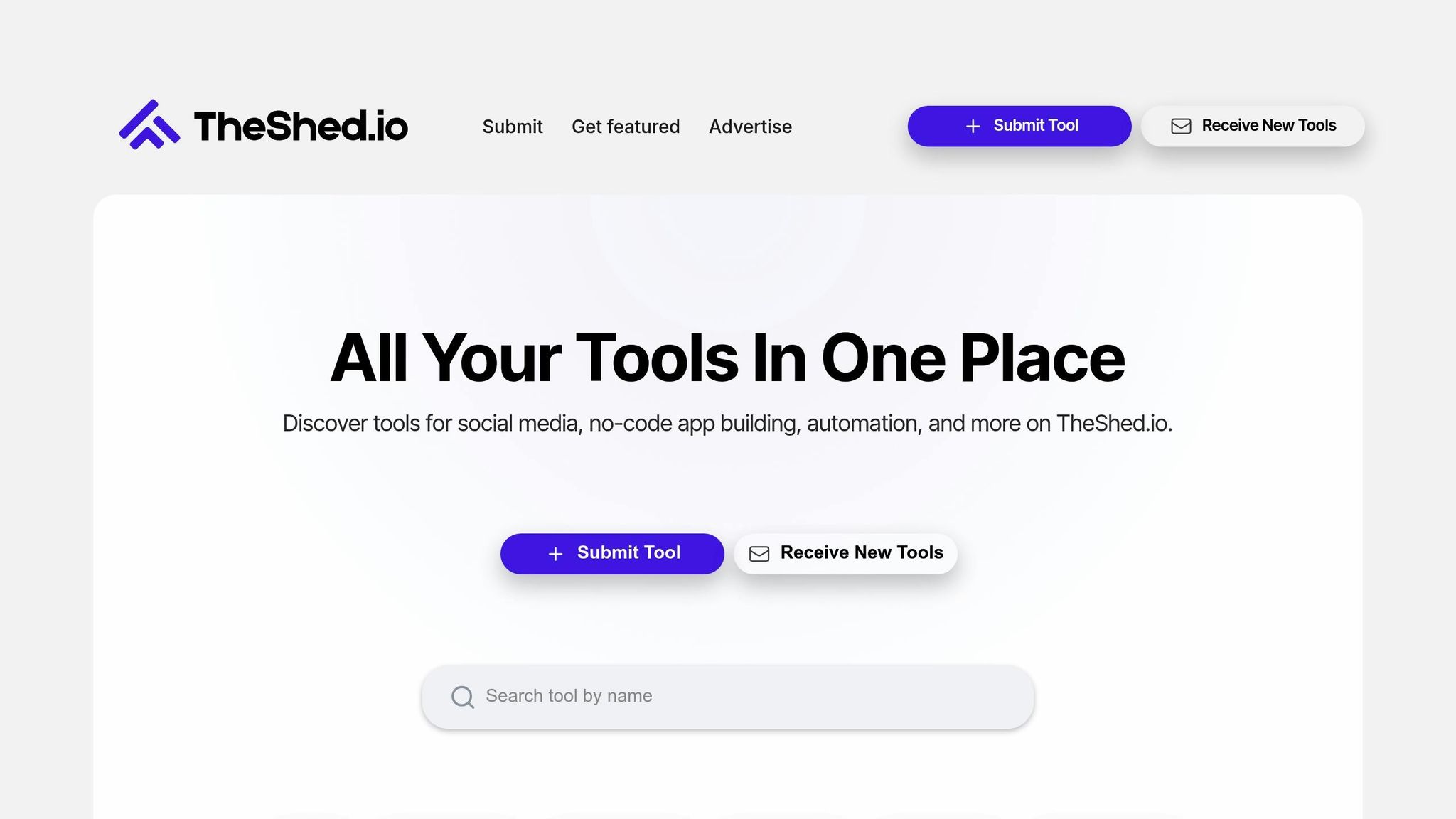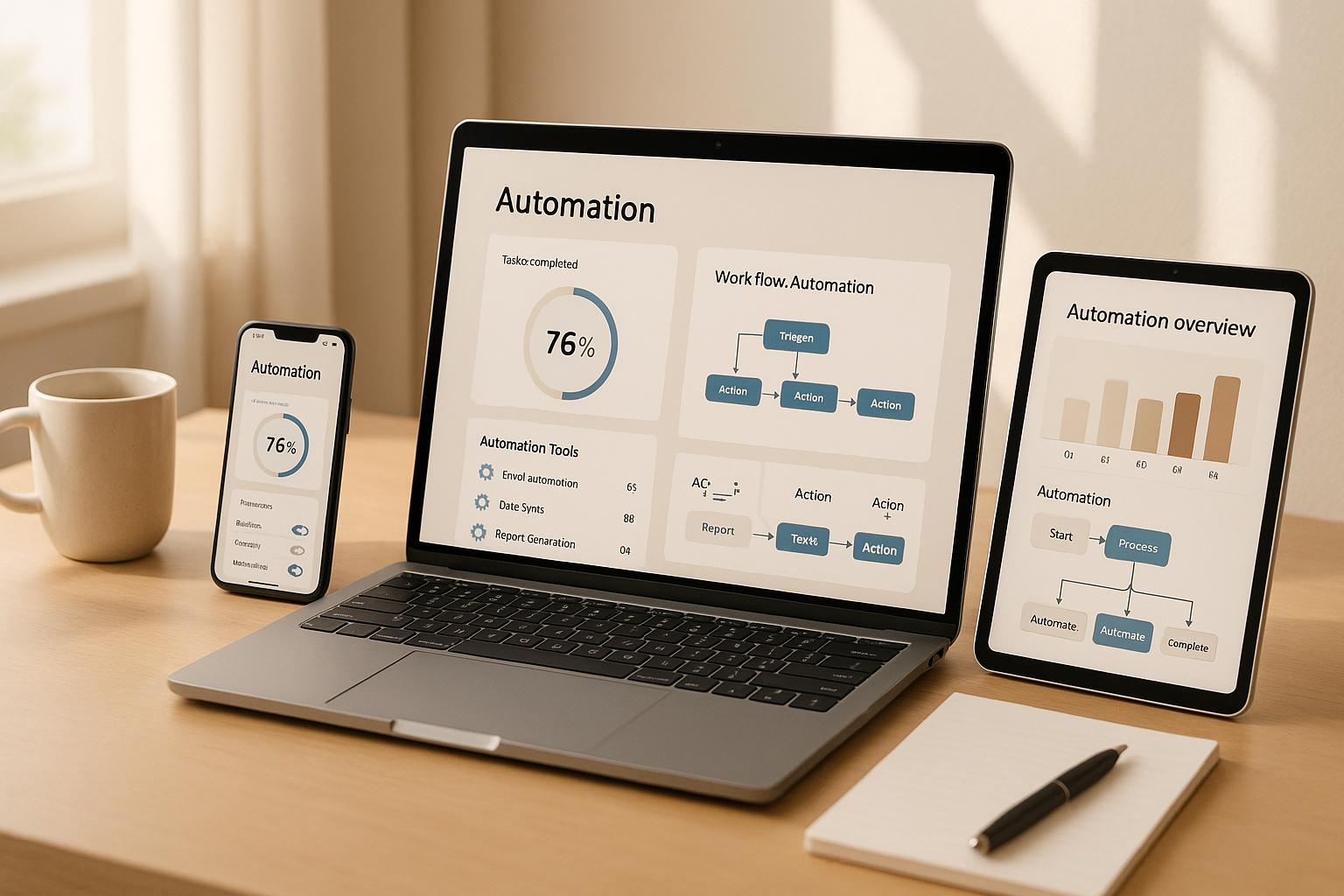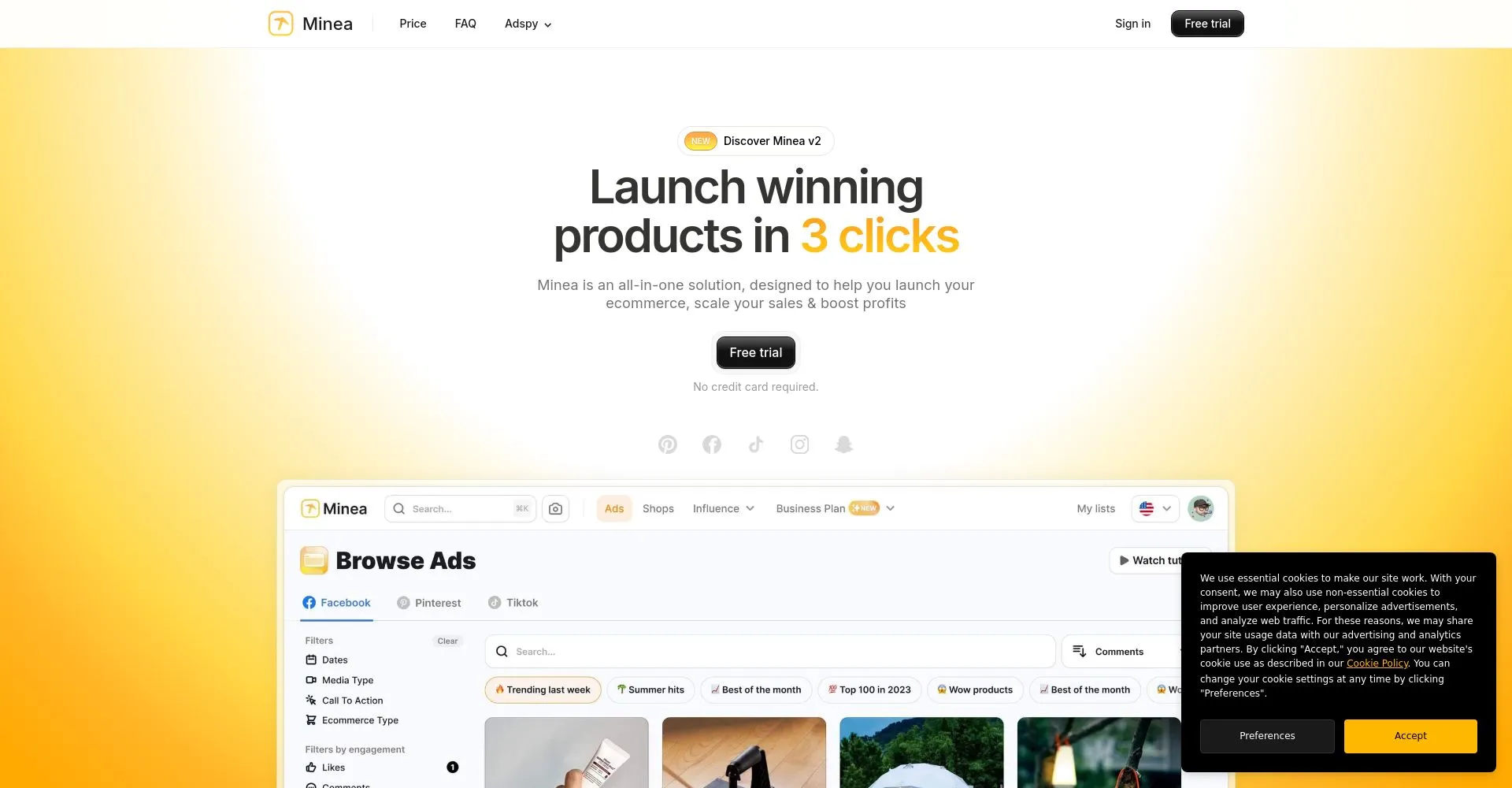UX Trends in No-Code Platforms 2025
By The Shed |
December 19, 2025

- AI-Driven Personalization: Platforms now use AI to predict user needs, automate workflows, and deliver tailored experiences. This reduces errors and speeds up app development by up to 60%.
- Accessibility-First Design: Legal compliance and better usability are driving platforms to integrate tools for building apps that meet WCAG standards, improving reach and user satisfaction.
- Community Collaboration: Shared resources, templates, and knowledge hubs are making it easier for users to build apps efficiently and solve problems together.
- Enterprise Integration: No-code tools are scaling to meet the demands of large organizations, offering features like role-based access control and seamless API integrations.
No-Code in 2025: Everything Designers NEED to Know
AI-Driven Personalization and Automation
Artificial intelligence is reshaping how no-code platforms deliver user experiences, making them smarter and more intuitive. By 2025, an estimated 65% of application development will rely on no-code AI platforms, with 72% of companies already using AI in at least one area of their operations. This evolution isn’t just about technology - it’s redefining how users engage with and benefit from no-code tools.
One major advancement is the breakdown of traditional barriers between complex functionality and user-friendly design. Instead of navigating through layers of complicated menus, AI-powered platforms anticipate user needs and handle repetitive tasks before users even ask.
AI-Powered UI and Workflow Automation
Today’s no-code platforms are leveraging AI to simplify interface creation and automate workflows. Using natural language prompts, these platforms can generate user interfaces and backend logic. Users simply describe their requirements in plain English, and AI takes care of the rest, turning ideas into functional applications.
Take Microsoft Power Automate & AI Builder, for example. In the financial sector, it automates tasks like loan processing and customer onboarding. The platform analyzes workflows, identifies bottlenecks, and suggests improvements - tasks that traditionally required technical expertise.
"AI is redefining what's possible with app building... By automating complex development tasks, AI enables anyone - from marketers to product managers - to design, build, and launch apps in a fraction of the time."
– Airtable
The impact on efficiency is striking. AI-powered workflow automation can slash development costs by up to 60%, reducing the need for specialized developers. By automating repetitive tasks with precision, AI also minimizes costly human errors.
For instance, Zapier Central showcases how AI simplifies tasks like email drafting, content summarization, and triggering workflows. Alex Danvers, a Systems and Automation Consultant, highlights this by saying, "This feature exemplifies how AI can simplify tedious tasks and enhance efficiency".
What sets AI-powered systems apart is their ability to learn and adapt. Unlike traditional automation, which follows fixed rules, AI evolves based on user behavior and feedback, continually refining workflows to make them more efficient.
Personalized User Experiences
AI-driven personalization goes beyond basic customization. It adapts in real time to individual user behaviors and preferences. For example, Google Vertex AI is used in healthcare to analyze vast datasets, predict patient outcomes, and create tailored treatment plans. This same technology is now being applied to no-code platforms, enabling them to deliver highly personalized experiences.
This personalization extends to interface design, too. AI studies user interactions with applications and adjusts layouts, navigation paths, and feature visibility automatically. In e-commerce platforms built on tools like Bubble, AI plugins analyze customer behavior and provide targeted marketing, all without requiring users to grapple with complex algorithms.
The growth of the hyperautomation market reflects this trend. Valued at $49.5 billion in 2025, it’s projected to reach $235.9 billion by 2037, with a compound annual growth rate (CAGR) of 13.9%. This surge underscores the increasing importance of AI-powered personalization in building competitive applications.
"No-code AI platforms make it possible for non-technical users to create sophisticated automation solutions without needing extensive coding knowledge. This combination enhances efficiency and allows users to focus on higher-value work."
– Leeway Hertz
These advancements not only enrich user experiences but also make technology more accessible, fostering innovation across diverse communities.
Pros and Cons of AI Integration
While AI integration offers numerous advantages, it also brings challenges that organizations need to address when adopting no-code platforms.
| Advantages | Limitations |
|---|---|
| Empowering Non-Technical Users: Enables anyone to create automation solutions | Ongoing Expertise Needed: Managing AI models and ensuring performance requires specialized knowledge |
| Cost Savings: Cuts development costs by up to 60% compared to traditional methods | Job Concerns: Potential resistance from employees worried about job displacement |
| Greater Accuracy: Reduces human errors with consistent task execution | Security Challenges: Ensuring data protection and meeting compliance standards becomes more complex |
| Data-Driven Insights: AI uncovers actionable insights from vast datasets | Bias Risks: Algorithms may reflect biases if training data is flawed |
| Enhanced Customer Service: Provides more personalized and responsive interactions | System Dependency: Over-reliance on AI can create vulnerabilities if systems fail or need maintenance |
To maximize the benefits of AI integration, organizations should start by automating repetitive, error-prone tasks. Setting clear goals and choosing tools that align with existing systems and team capabilities are key to successful implementation.
"The combination of AI and no-code tools democratizes technology, making it easier for anyone to create and implement innovative solutions without waiting for traditional development timelines."
– Leeway Hertz
With 75% of large enterprises expected to use at least four low-code development tools by 2025, understanding the opportunities and challenges of AI integration is critical. This evolving landscape is paving the way for more accessible and inclusive no-code platforms, setting the stage for the future of application development.
Accessibility and Inclusive Design
No-code platforms are stepping up their game when it comes to accessibility-first design. This shift is driven by both legal obligations and practical benefits. For example, in 2024 alone, over 4,500 digital accessibility lawsuits were filed in the U.S. under the ADA. As a result, platforms are embedding accessibility features to help users build compliant applications right from the start.
Accessible design doesn’t just meet legal requirements - it makes good business sense. It can expand your audience by 15% and boost conversion rates by as much as 20%. But here’s the catch: a staggering 96% of websites still fail to meet WCAG standards. This gap has pushed no-code platforms to focus on compliance and adaptive design techniques.
"As the digital world becomes more inclusive, web accessibility is no longer optional - it's a competitive advantage, legal necessity, and a core user experience (UX) standard."
– Stefan Ivic, Author, Broworks
To bridge this gap, platforms are integrating accessibility tools directly into their design processes.
WCAG Guidelines Adoption
No-code platforms are taking WCAG guidelines seriously, embedding them into their workflows to make accessibility a seamless part of the design process. These guidelines provide a roadmap for creating content that works for users with disabilities, whether they are visual, auditory, physical, cognitive, or neurological.
Many platforms now include features that automatically flag issues like missing alt text, poor color contrast, or improper heading structures. These tools help users create applications that meet WCAG 2.1 AA standards without requiring advanced technical skills.
Education is also a big part of the picture. Platforms are offering workshops and detailed documentation to teach users how to incorporate inclusive design from the beginning, saving time and money by avoiding expensive fixes down the line.
Responsive and Assistive Features
With mobile devices accounting for 59% of all web traffic, ensuring accessibility across different screen sizes is critical. Modern platforms are addressing this by incorporating assistive technologies like voice-activated navigation and adaptive layouts. These features are invaluable for users with motor disabilities or those who prefer hands-free interaction.
AI tools are also stepping in to simplify the process. They can automatically generate alt text for images or suggest color adjustments to meet contrast standards, making compliance easier than ever.
Real-world testing has become a standard practice. Platforms are working with accessibility consultants and involving users with disabilities in usability tests to ensure their features truly meet practical needs. Mobile-specific enhancements, such as larger touch targets, simplified navigation, and gesture-based alternatives, are designed to work seamlessly with assistive technologies.
Accessibility Feature Comparison
Accessibility isn’t just about inclusivity - it also brings measurable benefits to user experience and business outcomes. The table below highlights how specific features impact both SEO and conversion rates:
| Accessibility Feature | SEO Benefit | Conversion Rate Optimization Benefit |
|---|---|---|
| Semantic HTML | Improves indexing and content structure | Enhances readability and user understanding |
| Alt Text for Images | Boosts image SEO and search engine context | Provides essential information for all users |
| Fast, Accessible UI | Improves Core Web Vitals scores | Lowers bounce rates and increases satisfaction |
| Transcripts & Captions | Adds searchable, rich content | Expands audience engagement |
| Form Labels | Supports structured data markup | Encourages more lead form completions |
Looking ahead, no-code platforms are exploring more personalized accessibility options. Adaptive interfaces that adjust layouts and content based on individual preferences are on the horizon. These go beyond traditional responsive design to deliver tailored, inclusive experiences.
AI is also playing a growing role by identifying and resolving accessibility issues. From generating alt text to suggesting compliant color schemes, these tools make it easier for designers to create accessible content without tedious manual checks. The future of accessibility is about making inclusive design not just possible, but effortless.
Community-Driven Templates and Resources
The no-code movement has sparked a remarkable transformation: active communities coming together to share knowledge, templates, and solutions. This wave of collaboration is redefining how apps are built, making the process faster and more inclusive. By pooling resources, these communities are not only saving time but also opening the doors for anyone with an idea to create something impactful.
Breaking Down Barriers with Shared Resources
Community-driven resources have leveled the playing field. Instead of starting from scratch, users can access a treasure trove of pre-built components, shared expertise, and proven solutions. This approach doesn’t just save time - it makes app development accessible to everyone, regardless of technical skill.
The numbers back this up. NoCodeFounders now connects over 2,000 no-code creators worldwide. NoCode.tech has gathered a community of 500+ members, and NoCodeDevs links 750+ members across 50+ countries. Even Reddit’s no-code group has attracted 13,100 followers. These stats highlight a thriving global network of builders who are shaping the future of app creation.
This collective mindset has also fueled a booming market for ready-made templates and tools that make prototyping easier than ever.
Pre-Built Templates and Prototyping: A Game-Changer
Templates have become the go-to tool for no-code developers. Instead of agonizing over design choices or layout challenges, creators can zero in on what matters most: bringing their vision to life. Many platforms now offer extensive template libraries for everything from e-commerce sites to productivity apps.
Modern templates are built with flexibility in mind. They’re mobile-friendly, visually polished, and customizable. Users can tweak colors, swap images, rearrange elements, and mold the template to reflect their brand’s identity. This adaptability allows developers to test ideas quickly, gather feedback, and make improvements without wasting time.
The key is finding templates that strike the right balance - offering a solid foundation while leaving room for creativity. The best templates act as springboards, not constraints, enabling developers to craft apps that feel original and tailored to their needs.
But templates are just one part of the story. The real magic of the no-code movement lies in its collaborative spirit.
The Power of Knowledge Sharing
No-code communities have become hubs of shared learning, like a specialized version of Stack Overflow for app builders. These spaces encourage collaboration, sparking new ideas and creative problem-solving.
Take Makerpad, for example. This platform combines education with community support, helping users navigate hundreds of tools and understand which ones suit their workflows best. The value of this approach is clear in the feedback from members:
"Makerpad is hands down one of the best communities I've been fortunate to be a part of - I've never been more confident that I have the tools, resources, and support needed to build and grow my business", - Tessa Thomas, Founder of Recruit-HQ
These communities go beyond just answering questions. They host workshops, tutorials, webinars, and even offer spaces for members to showcase their creations. Builders share their wins, troubleshoot together, and often form partnerships that extend beyond the community itself.
"NCF is one of the best founder communities out there. NCF has brought together high-caliber, collaborative, and engaged founders building great businesses with no-code", - Emmanuel Straschnov, CEO of Bubble
Practical perks like discounts on no-code tools are a nice bonus, but the real value lies in the collective wisdom and unwavering support these groups provide. Members continually learn from one another, staying up-to-date on emerging tools and creative solutions.
As Leslie Burke, Head of Product and Operations at LassoBook, puts it:
"This community consistently updates me on emerging tools and novel ways they can be joined together to solve real business problems. I keep coming back to have my imagination stretched by the people in this group"
The collaborative nature of these communities is reshaping the no-code landscape. Builders no longer have to face technical hurdles alone - they can lean on collective knowledge, speed up their learning curve, and create better solutions. This shared expertise not only streamlines development but also ensures that the end results are practical, polished, and user-focused.
sbb-itb-9a5c6df
TheShed.io: Directory for No-Code Tools

Finding the right no-code platform can feel overwhelming, especially with so many options out there. That’s where TheShed.io comes in - it simplifies the process by bringing together tools and resources for no-code, automation, AI, productivity, and design into one centralized hub. With everything in one place, users can easily explore and compare solutions tailored to various tasks, making it easier to choose the right platform with confidence.
Key Features and Advantages
What sets TheShed.io apart is its thoughtfully organized approach to tool discovery. Instead of scrolling through endless, unstructured lists, users can dive straight into specific categories like no-code app builders or automation tools. This streamlined navigation saves time and ensures users can quickly find tools that align with their project goals.
The platform also goes beyond simple listings. Each tool comes with a detailed breakdown of its features, pricing, and technical compatibility. This allows users to evaluate whether a tool fits their needs - both functionally and financially - before investing time in testing or implementation.
For businesses looking to connect with no-code creators, TheShed.io offers advertising opportunities. This creates a space where high-quality tools can gain visibility while users benefit from a curated selection of proven solutions. By focusing on organized and actionable insights, TheShed.io ensures users can identify platforms that prioritize usability and efficient design.
How TheShed.io Enhances UX Evaluation
Good user experience (UX) is the backbone of any successful project, and TheShed.io makes it easier to find platforms that excel in this area. By emphasizing accessibility and responsive design, the platform helps users compare critical UX features across different tools.
Each tool listing includes essential details like WCAG compliance, assistive technologies, and customization options - key factors for creating inclusive and user-friendly designs. The platform’s clear categorization also highlights tools with specific UX strengths, allowing users to quickly pinpoint solutions that meet their unique requirements.
With its focus on accessibility and usability, TheShed.io doesn’t just help users find tools - it ensures they find the right tools to create seamless, inclusive applications.
Future Outlook: Enterprise Integration and Scalability
The no-code movement is evolving rapidly, especially as large organizations begin to see these platforms as more than just tools for simple app creation. What started as a way to build basic applications has grown into a solution capable of handling enterprise-level workflows, integrations, and user demands.
Enterprise-Scale Adoption
The adoption of no-code platforms by enterprises has skyrocketed. A striking 87% of enterprise developers now use low-code platforms in some capacity. These tools are no longer limited to quick prototypes - they’re being used for critical applications like dashboards, workflow automation, and secure integrations.
The financial benefits are hard to ignore. Companies using low-code platforms report an average 58% boost in revenue, along with a 70% reduction in development costs and a 40% drop in maintenance expenses. It’s no surprise, then, that 81% of businesses see low-code as strategically important, with 31% making it a core part of their software approach.
Security and governance are now key priorities for enterprises adopting no-code solutions. Modern platforms offer advanced features like role-based access control (RBAC), single sign-on (SSO), audit logs, and seamless integration with CI/CD pipelines. They also connect effortlessly with legacy systems through REST and GraphQL APIs. However, these enterprise-grade capabilities come at a price - OutSystems starts at $36,300 annually for 100 internal users, while Mendix’s paid plans begin at $998 per month. These investments reflect the growing importance of robust, scalable no-code solutions in today’s market.
Predictions for 2025 and Beyond
No-code platforms are poised to drive rapid digital growth in the coming years. By 2025, these tools will become even more integral to enterprises, especially as citizen developers - non-technical users building apps - are expected to outnumber traditional developers by a ratio of 4:1 by 2026. This shift will redefine how IT and business teams collaborate.
AI is shaping the next wave of no-code platforms. By integrating AI to predict user needs, offer recommendations, and automate development tasks, these platforms are becoming easier for non-technical users while enabling more sophisticated application creation.
The market for low-code solutions reflects this momentum. By 2030, it’s projected to hit $101.7 billion, fueled by the demand for faster digital transformation and the ongoing shortage of traditional developers. Industry-specific solutions are also on the rise, offering pre-built templates and compliance features tailored to sectors like healthcare, education, and retail. These advancements allow companies to deploy solutions faster while meeting strict regulatory standards.
Competition in the no-code space is heating up. Platforms like OutSystems, Appian, and Power Apps consistently earn high satisfaction ratings (4.5 stars or above), while niche players like Quixy are rated as high as 4.9 out of 5. Cross-platform development is becoming the norm, enabling businesses to create applications that work seamlessly across web, mobile, and desktop environments. Built-in security measures ensure data protection and compliance are prioritized from the start, making these platforms ideal for scaling complex digital projects.
These trends highlight a future where no-code platforms will be at the heart of enterprise innovation. With their ability to scale, integrate, and secure even the most complex initiatives, these tools are redefining how businesses approach digital transformation, making technology more accessible and intelligent for everyone involved.
Conclusion
By 2025, no-code UX is set to reshape digital transformation by combining AI-driven personalization, accessibility-first design, community collaboration, and enterprise scalability. These trends, explored in detail above, highlight the transformative power of no-code technologies.
Consider this: 70% of new enterprise applications are expected to rely on low-code or no-code solutions by 2025, supporting a market projected to hit $187 billion by 2030. Additionally, 90% of users report faster company growth with these tools. As Tim Srock, CEO of Mendix, explains:
"Low-code/no-code platforms allow organizations to combine the expertise of business and IT and the knowledge of the entire enterprise to build applications that can deliver unique customer experiences."
AI integration is a game-changer, poised to deliver over $50 billion in enterprise benefits by 2030. On top of that, accessibility is taking center stage, with regulations like the European Accessibility Act and WCAG 2.2 guidelines opening new opportunities and ensuring inclusive digital experiences.
Community-driven development is another key factor, enabling faster innovation through modular templates and shared resources. This approach empowers businesses to create advanced applications that adapt and scale with their needs.
Platforms like TheShed.io bring these advancements together, offering a hub of no-code tools for AI, productivity, design, and development, helping teams find tailored solutions to meet their goals.
As Eric Simone, CEO of ClearBlade, succinctly puts it:
"No-code innovation is here to stay."
The real challenge isn't deciding whether to adopt these technologies, but how quickly and effectively businesses can integrate them into their strategies. Companies that act now will position themselves as leaders in the evolving no-code landscape, ready to innovate and thrive in the digital economy.
FAQs
How does AI-driven personalization enhance user experience and efficiency in no-code platforms?
AI-powered personalization is reshaping no-code platforms, making them smarter and more user-friendly. By studying user preferences and behaviors, these platforms can adjust interfaces, workflows, and content to better suit individual needs. The result? Applications that feel custom-made and easier to navigate.
This personalized approach doesn’t just simplify things for users - it also enhances their overall experience by delivering solutions that match their needs faster. For businesses, this means creating more efficient, user-focused applications that save time and increase productivity.
What are the benefits of prioritizing accessibility in no-code platforms, and how does it influence business success?
Prioritizing accessibility in no-code platforms ensures that applications are functional and welcoming for a broader audience, including individuals with disabilities. This focus not only improves usability and enhances the overall user experience, but also makes these platforms more inclusive - ultimately encouraging stronger customer satisfaction and deeper engagement.
On the business side, embracing accessible design opens doors to a larger customer base, bolsters brand reputation, and ensures adherence to legal requirements. These benefits build trust and can lead to higher revenue and sustained profit growth. By making accessibility a priority, businesses demonstrate both forward-thinking and a commitment to social responsibility.
How are community-driven templates shaping the future of no-code app development?
Community-driven templates are transforming no-code app development, making it easier than ever to build applications. These templates, which include reusable modules and pre-designed components, help cut down on development time and simplify the process. This means even those without a technical background can dive into app creation with confidence.
By sharing templates, tips, and automation strategies, users create a collaborative space where ideas and solutions thrive. This shared approach not only speeds up development but also opens the door for more people and businesses to bring their app ideas to life, leveling the playing field in app development.
.svg)






